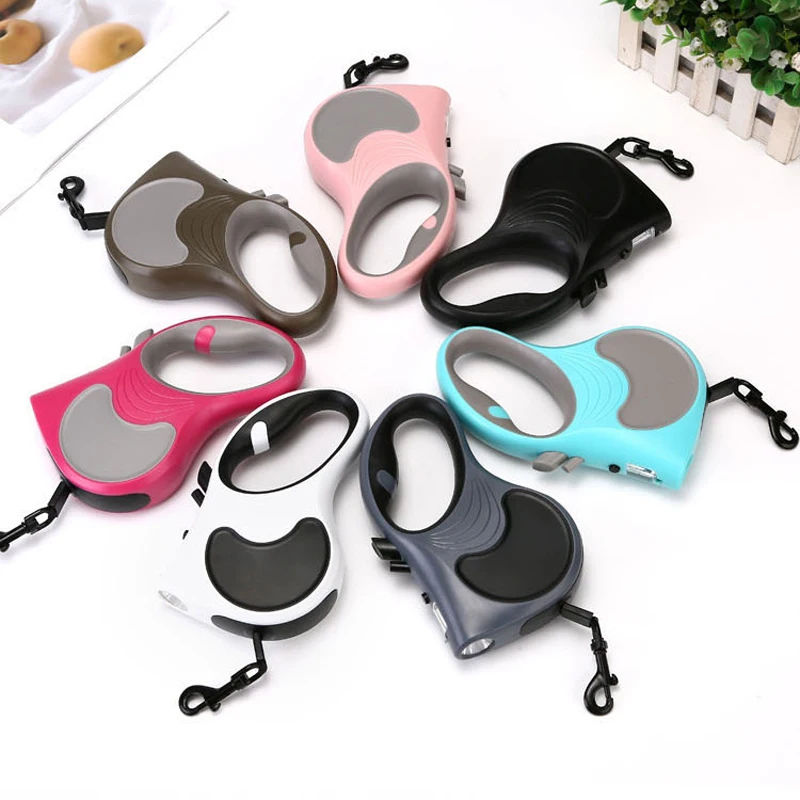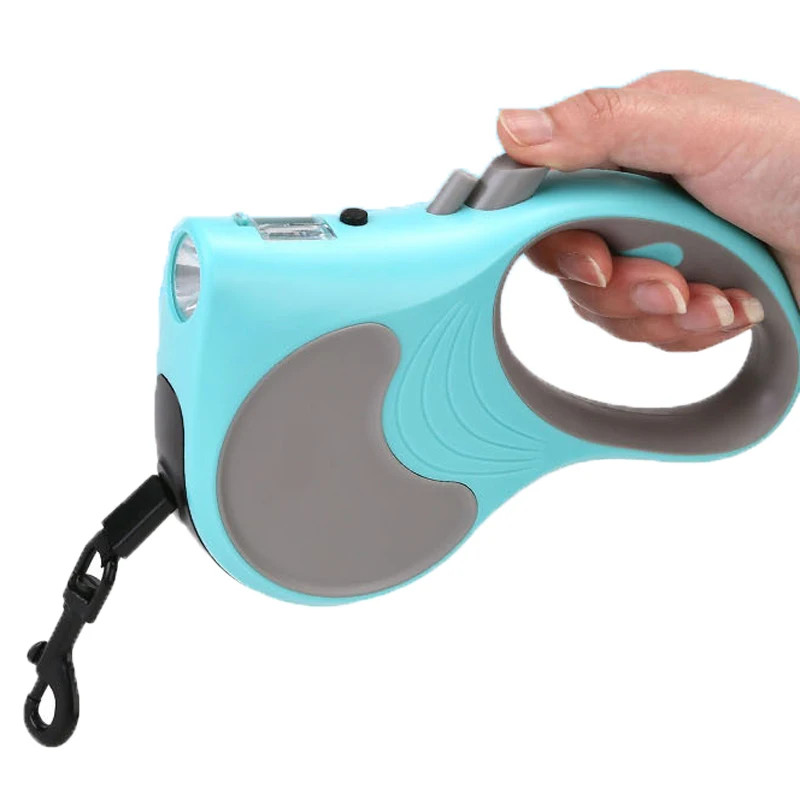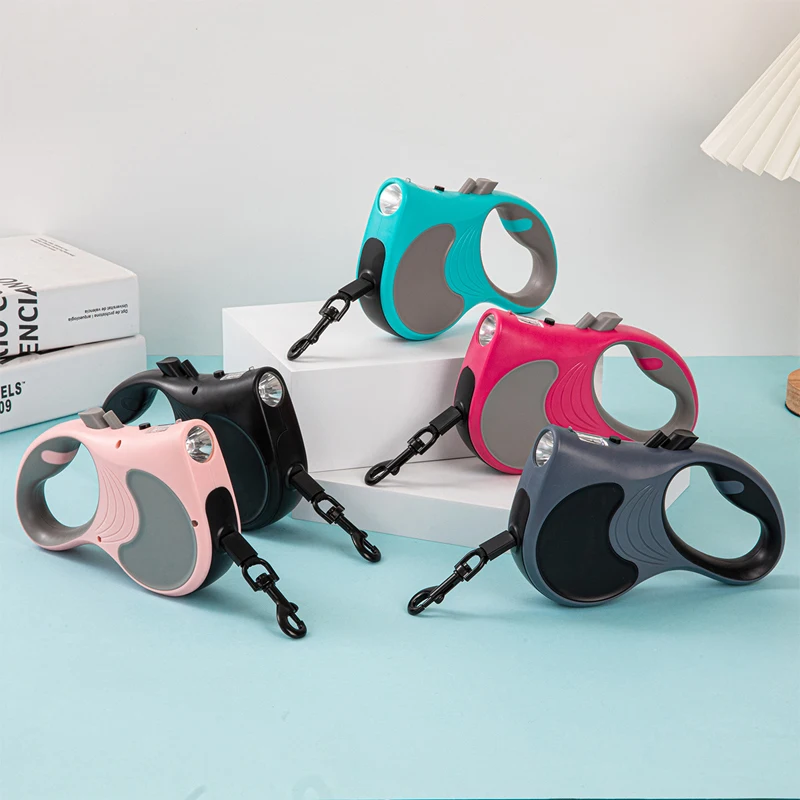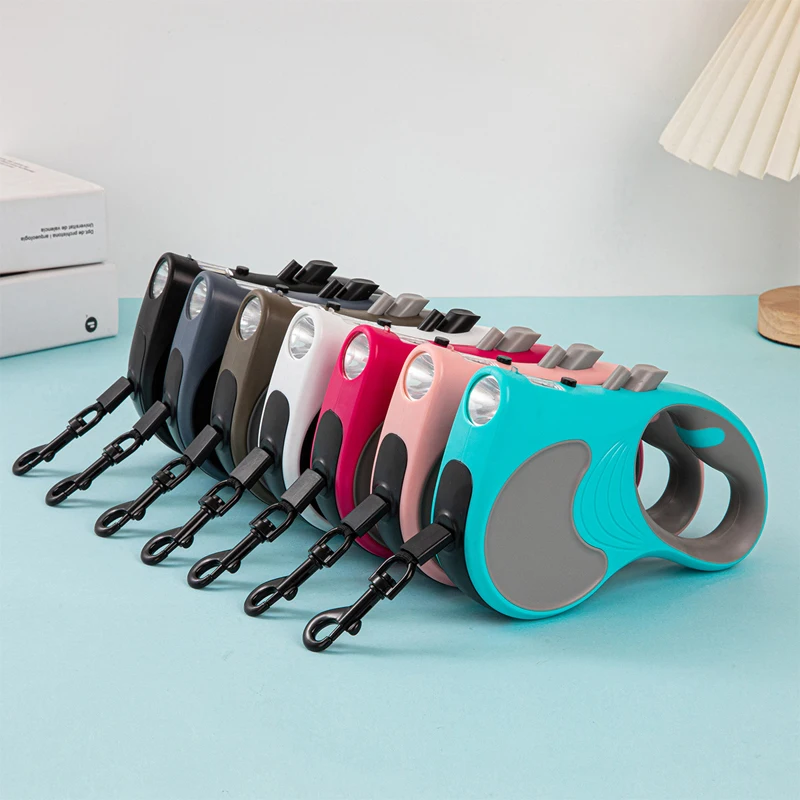Introduction to Retractable Leashes
Retractable leashes, often known as ‘flexi leads’, offer dogs more freedom on walks. Yet, they have sparked much debate over their safety.
Brief History and Design
The retractable leash, created in 1972 by Manfred Bogdahn, was designed to mix freedom with control during dog walks. These leashes feature a coiled spring mechanism inside a plastic handle. A button lets the owner control the length of the leash.

Potential Risks Associated with Retractable Leashes
Retractable leashes can pose risks to both dogs and their owners.
Distance and Lack of Control
Extended leashes mean dogs can wander far from owners. This can lead to trouble. Too much distance may prevent timely control over a dog’s actions. Situations can change swiftly, especially near traffic or with unfamiliar encounters.
Durability Concerns and Breakage
The thin cords on some retractable leashes can snap. A strong, sudden pull from a big dog could cause breakage. This might lead to uncontrolled dogs or even cause the cord to retract and injure the owner.
Injuries to Dogs and Humans
Retractable leashes have caused burns, cuts, and in severe cases, amputations. The sudden jerk from a dog running out of leash can hurt both the dog and owner. Entanglement with the leash can also occur, adding to the injury risk.
Specific Scenarios Where Risk Increases
Risks are higher near traffic, among crowds, with untrained dogs, and for reactive or fearful dogs. Busy areas amplify the chance of injury. Retractable leashes are not suitable where controlled environments are uncertain.
Appropriate Situations for Retractable Leash Use
While retractable leashes pose various risks, they have specific uses where they can be effective and safe.
Controlled Environments and Trained Dogs
Retractable leashes can be useful in controlled settings where risks are minimized. These environments should be free from dense traffic or large crowds, which significantly reduce potential hazards. Also, they are best used with dogs that have undergone basic obedience training. This training ensures that the dog can respond to commands at a distance, reducing the chance of unexpected situations. Therefore, using a retractable leash in an enclosed park or private garden can offer your dog freedom while maintaining safety.
Special Use Cases: Potty Breaks and Open Fields
For short, supervised outings like potty breaks or quick walks on open fields away from traffic, retractable leashes offer convenience and sufficient control. They give dogs the liberty to explore a bit further away while still being under the owner’s control. Similarly, if you’re travelling and need to stop at roadside rest areas, a retractable leash allows your dog more room to stretch and relieve itself without endangering it by straying too far.

Alternatives to Retractable Leashes
While retractable leashes offer freedom, they’re not always safe. Knowing the risks, let’s explore safer alternatives.
Standard Flat Leashes
Flat leashes are a solid option for most dog owners. Their fixed length keeps your dog close and safe. They make it easier to control your dog in busy places. No sudden pulls or risky leash snaps. They’re also simpler to hold onto. Flat leashes are better for training walks too. They teach your dog not to pull. With lengths usually around six feet, they’re ideal for controlled environments.
Long Leads/Drag Lines
Long leads, also known as drag lines, offer a middle ground. They give dogs freedom but are safer than retractable leashes. They’re typically made of sturdy materials like Biothane. You can step on them to regain control if needed. Great for training recall in open, quiet areas. Be ready to manage the excess length. Long leads don’t retract, so they’re not as prone to malfunction. Remember to check them for wear and tear regularly.
Safety Precautions for Using a Retractable Leash
Retractable leashes, if chosen for use, must come with strict safety measures. Prioritizing regular checks and careful handling can prevent mishaps.
Regular Maintenance
Check the leash often for signs of wear or damage. Frays or cracks in the cord can lead to breaks. A good look at the handle and locking mechanism is important. These should work without fail. Replace a leash that shows any sign of possible failure.
Suitable Environments and Attentive Handling
Choose the right setting for a retractable leash. Avoid busy streets, crowded places, and areas with potential hazards. Be mindful and keep your focus on the dog when using this leash. Anticipate your dog’s moves and be ready to act. Remember, vigilance is key to prevent the leash from slipping or the dog bolting. Use a retractable leash with trained dogs that respond when called. Stick to open fields or private parks when using this type of leash. Always have a firm grip and never let the leash handle dangle or drag.
Proper Leash Length and Control
Retractable leashes can extend from a few feet to over 20 feet, but it’s essential to choose the right length for your environment. Shorter leashes (10 feet or less) are often better for urban areas or places with more distractions, as they allow you to maintain control over your dog without risking too much distance between you and your pet. Longer leashes are ideal for open spaces like parks, but always ensure that you can reel in the leash quickly if needed, particularly in situations where hazards or obstacles arise. A leash that is too long may result in tangles, or your dog may wander into dangerous situations faster than you can react.

Avoiding Sudden Tension and Jerking
One of the biggest risks of retractable leashes is the potential for sudden jerking or tension. These leashes are designed to retract, which means they can sometimes snap back quickly, especially if the dog makes a sudden movement. This can cause injury to both you and your pet. Avoid putting too much tension on the leash, and refrain from yanking it. If your dog pulls too much, stop moving and allow the leash to retract naturally before proceeding. Additionally, always keep a firm grip on the leash handle, avoiding holding it loosely or too tightly, which can lead to accidents or strain.
Leash Locking Mechanism and Brake Use
Many retractable leashes come with a locking mechanism or a brake feature, which can help control the length of the leash. It’s crucial to understand how this feature works and use it effectively. When your dog is close by, or when you need to prevent them from running into potential danger, lock the leash in place. The brake should be used when you need immediate control, such as when crossing roads or preventing the dog from running towards distractions. Make sure the brake or lock mechanism is functioning smoothly, as any malfunction could result in your dog getting away or becoming tangled.
Supervision and Training
Retractable leashes should never be used without supervision. Even the most well-trained dog can get distracted, and the longer leash length gives them more freedom, increasing the risk of them getting into trouble. It’s important to train your dog to respond to commands reliably, especially recall commands, before using a retractable leash in more open or uncontrolled environments. The leash should be used as a tool for positive reinforcement, not as a substitute for proper training.
Choosing the Right Leash for Your Dog
When selecting a retractable leash, consider the size and strength of your dog. Larger or stronger dogs may require leashes that are more durable and can withstand more tension, while smaller dogs may need lighter, more compact models. Be sure the leash is rated for your dog’s weight and strength. Some retractable leashes come with features such as reflective strips, comfort-grip handles, or even dual-dog capability, which can enhance safety and convenience. Always choose a high-quality leash from a reputable brand to ensure the best possible performance and safety.
Conclusion: Assessing the Right Choice for Your Dog
Choosing the right leash impacts both safety and freedom for your dog. When deciding if a retractable leash is suitable, several factors should be considered.
Factors to Consider
- Dog’s Temperament and Training: Well-trained dogs who respond promptly might handle more freedom with a retractable leash. However, reactive or easily scared dogs should avoid them.
- Environment: Wide, open spaces away from traffic and crowds are more suitable for retractable leashes. Busy or hazardous areas are not.
- Your Needs: Consider whether the flexibility or the potential risks of a retractable leash align with your walking habits and routes.
- Leash Features: Opt for a robust, well-engineered retractable leash if you choose one. Always check for malfunctions.
Making Informed Decisions
Weighing the pros and cons of retractable leashes is crucial. Regular flat leashes or long leads might be safer and simpler to manage in many situations. Understand your dog’s needs and your regular routes to make the best choice.
Ultimately, ensuring your dog’s safety and managing their behavior diligently should guide your decision on which type of leash to use.










